Do you ever wonder how brands like Gap and Zara pull off their sleek marketing campaigns? 🤔
It's not a fluke. These campaigns are planned down to the finest detail, from keyword strategy to optimized product descriptions and automated emails.
And this is where an eCommerce marketing plan comes into play. Think of it as your blueprint to successfully engage customers. A marketing plan will audit your current marketing efforts, outline which channels you will use and map strategies like abandon cart recovery and loyalty programs.
So, how do you get started with a successful eCommerce marketing strategy?
This step-by-step guide is going to show you how 👇
What is an eCommerce marketing plan?
An eCommerce marketing plan is a framework to help you brainstorm, organize and execute your brand's marketing strategy.
It looks at everything from the foundations of your current marketing efforts, like Search Engine Optimization (SEO) and email. It then digs deeper into strategies like customer segmentation, SMS marketing and social commerce. Even if you already use some of these marketing techniques, without a proper plan, it'll be messy and unorganized.
The problem most brands have when they think about a successful eCommerce marketing strategy is it's hard to know where to start.
Our advice?
Stick to strategies that engage customers and bring in revenue.
Here are 8 steps to do just that 👇
1. Audit your current strategy (and figure out how to improve it)
An audit analyzes every part of your current marketing plan to figure out what's working—and what's not.
It looks at any current strategies you use, like SEO, social media marketing and email campaigns, and measures them against key metrics to see what content your customers engage with. When building an eCommerce marketing plan, it's important to start with an audit as it:
🤔Gives an unbiased take on your strategy: That daily Instagram campaign you launched? Or the weekly newsletter with a product review? Yeah, you may think these are great ideas, but an audit is the only way to know if they are landing with customers. If you unpick your current marketing strategy, you can identify the strengths of your marketing efforts and find out where you need to make some changes.
🔍 Find holes in your marketing plans: An audit can find any opportunities you are missing to connect with your target audience. This may be oversights like not marketing on the right social media platforms.
🗑️ Cleans out your email list: List hygiene is super important as it weeds out any subscribers/customers that aren't engaging with your brand. A clean email list improves deliverability and increases the accuracy of metrics like open/bounce rates.
There are also other sections of your marketing strategy, like goal setting and budgets, that need to be looked at during this step.
We won't lie to you: a content audit isn't a job that will take an hour. You are ripping your current marketing strategy back to the studs, so put aside a week or two. This will give you a solid foundation to rebuild a successful eCommerce marketing plan when you move on to the next step.
Pro-tip: Does your eCommerce business need help with your content audit? Check out this super helpful guide on how to evaluate elements of your store like product pages, descriptions and inventory.
2. Optimize your eCommerce website for SEO
SEO isn't just for blog posts.
In terms of Google, the keywords, meta descriptions, and backlinks on your product pages can have a huge impact on where your store ranks. And ranking matters when you bring in customers. Backlinko found that page at the top of Google's organic SERPs is 10 times more likely to get a click compared to a page in spot #10.
Here are some specific tactics that an eCommerce business can use to optimize its website for SEO:
🔑 Nail your keyword research: Find keywords your customers are actually searching for. If your budget is tight, use a tool like Google Keyword Planner to find popular keywords and analyze organic search traffic. Or if you can afford it, Ahrefs or SEMrush give detailed breakdowns of keyword volume and backlink opportunities.
🤓 Optimize product pages: Add rich keywords, title tags, meta descriptions, URLs and product descriptions to every page. Don't forget to check that each page is mobile-optimized for customers shopping on a device.
🏃Improve site speed: A 3-second delay in page loading time can increase bounce rates by 32%. It's not rocket science—your eCommerce site needs to load as quickly as possible. Use this tool from Pingdom to test your current speed. If it's slow, try to make image files smaller or cut the number of JavaScript and CSS files on the page.
One brand that nails its SEO is Nordstrom. They have grabbed the #1 organic spot on Google for "men's chinos":
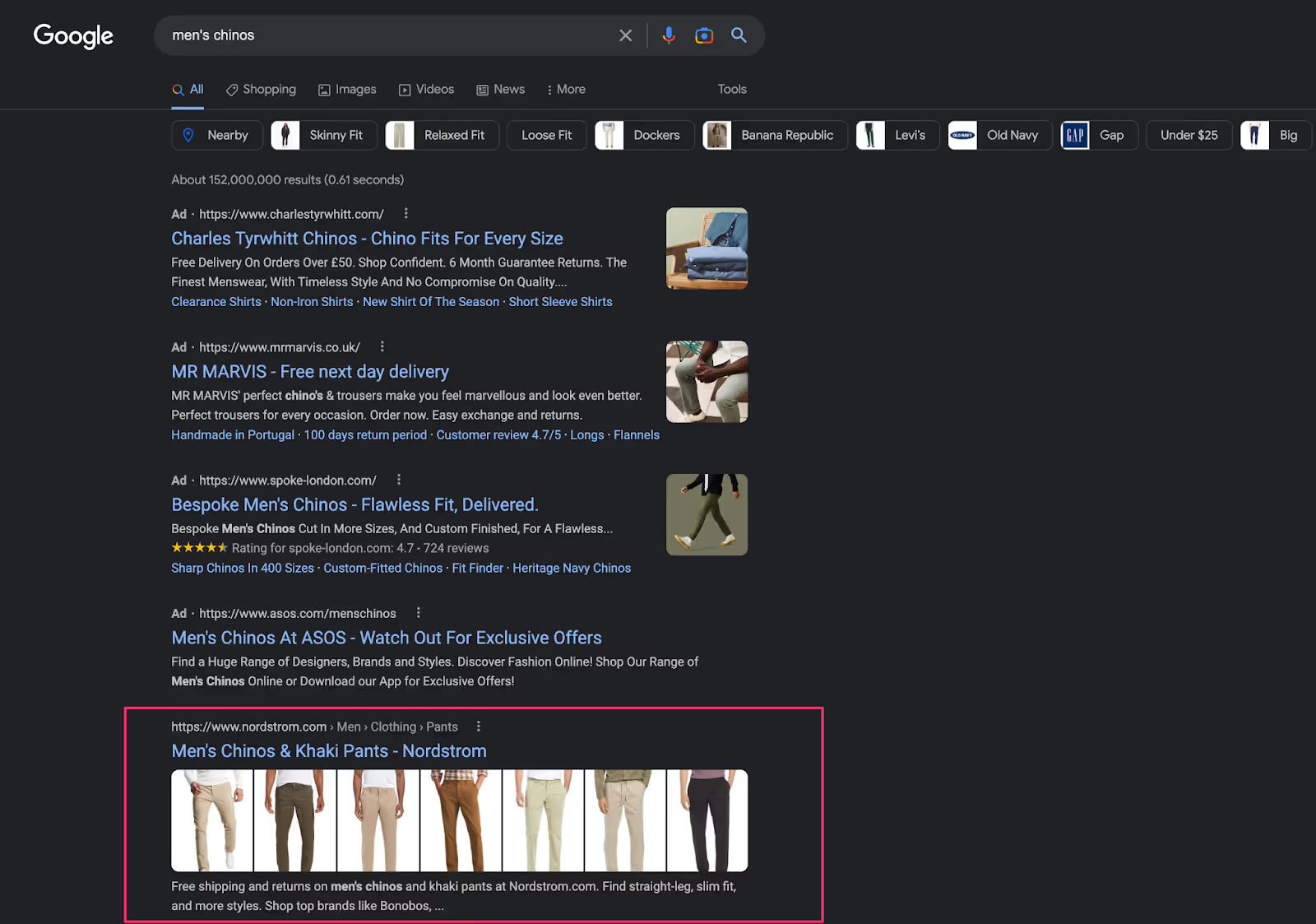
Once we click their link, it's easy to see why. The product page is optimized with images, video and a keyword-rich description so Google knows it's a match for what the customer is looking for.
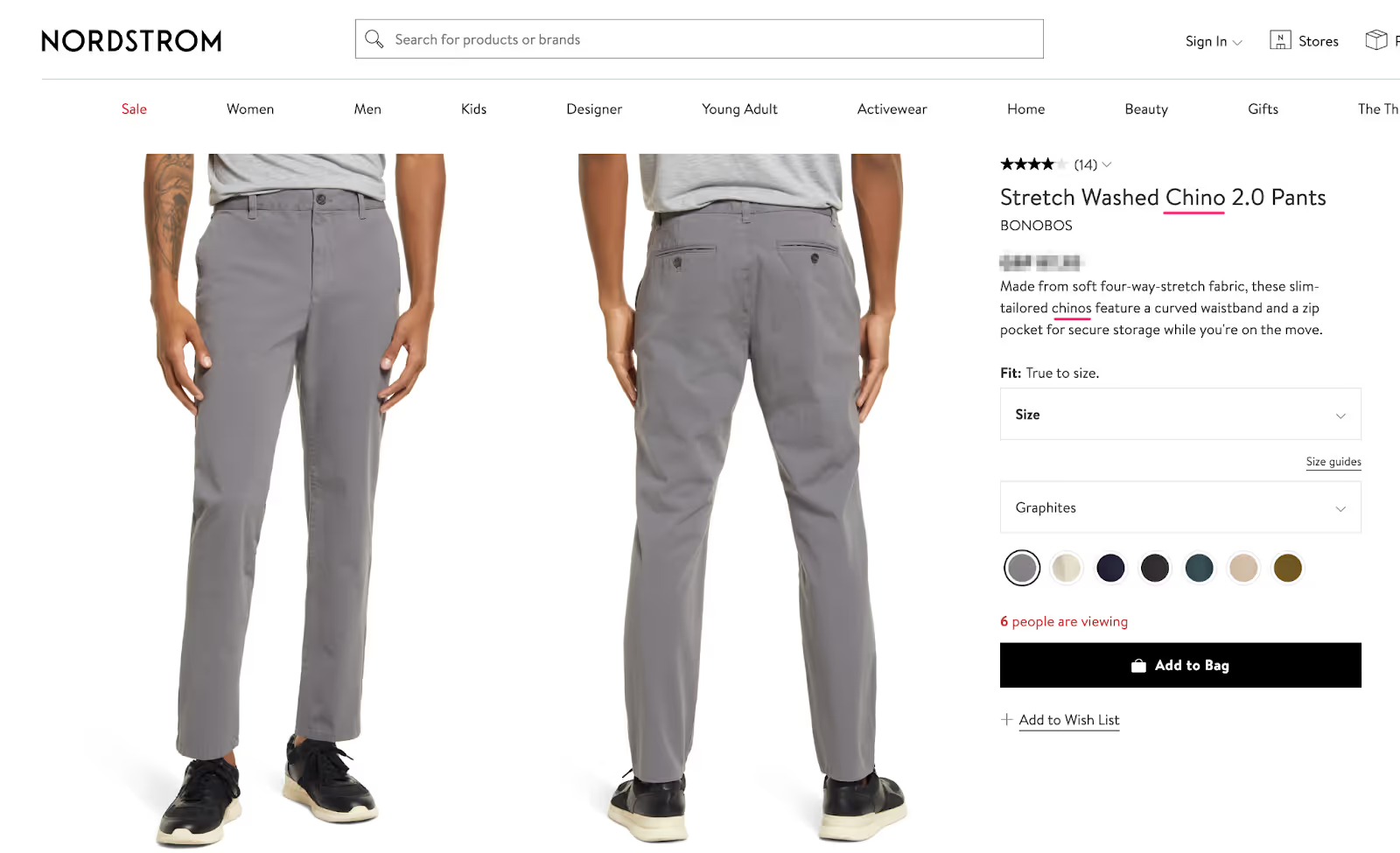
Shopify also recommends keeping your ideal customer in mind when writing product descriptions. Aim to make them "scannable" so they're easier to read. Underneath Nordstrom's product images, there is another super-detailed section with all of the information the customer needs in dot points:
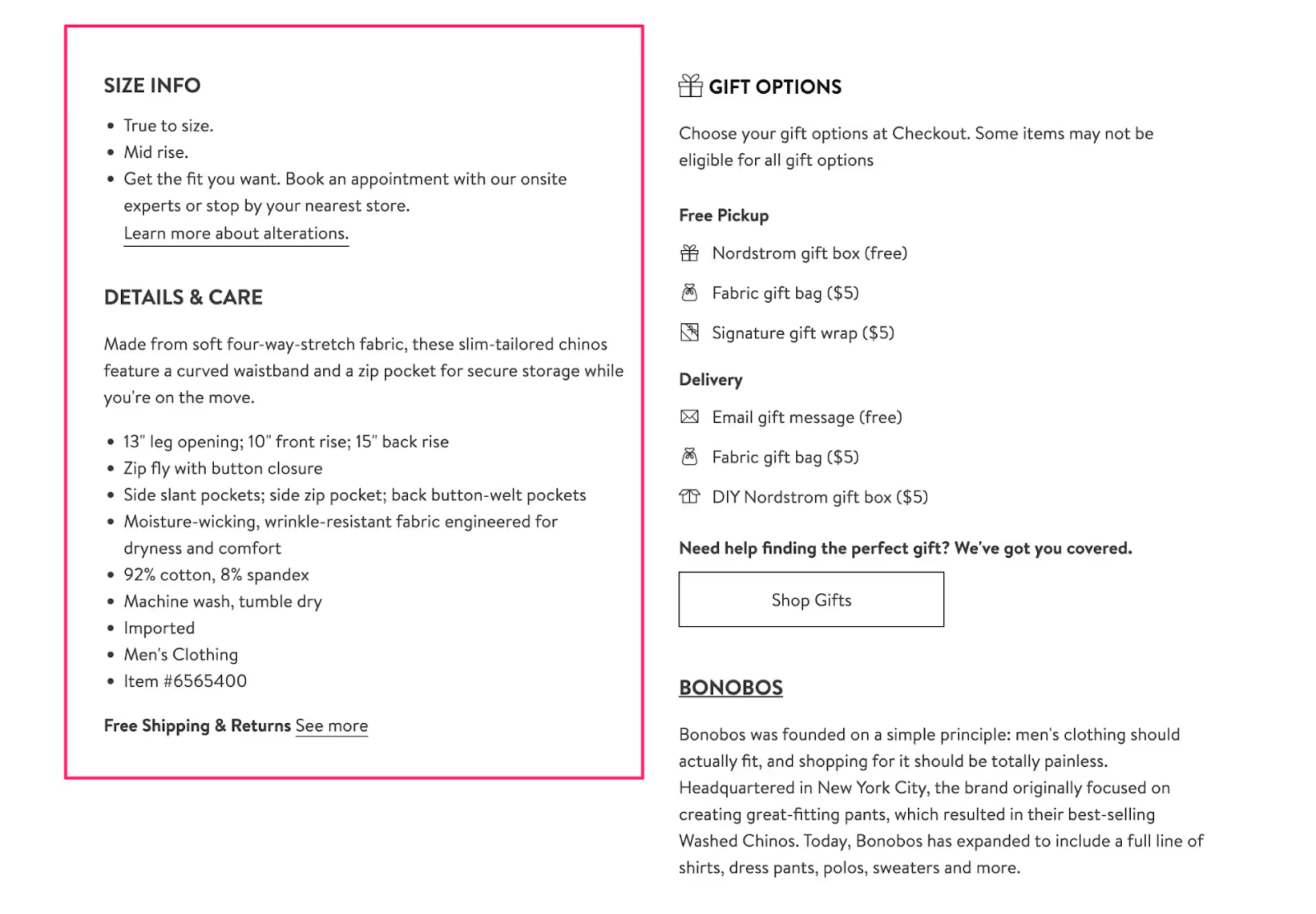
We think Nordstrom has hit it out of the park: they nailed the SEO and kept the product page aesthetically pleasing.
Remember this example when optimizing your product pages, website structure and speed. With some tweaks, your page can climb Google's ranks and bring in more organic traffic.
3. Segment customers by buying behavior for better targeting
It goes without saying that messages and digital marketing campaigns that resonate with a 20-year-old man are very different from those that land with another female customer in her 60s.
Segmentation is one of the most underrated strategies in eCommerce marketing. It can increase customer trust and loyalty over the long run as it proves you are thinking about their specific needs. You can segment customers based on their:
🌎Demographics: Target customers based on their gender, location, purchase history and preferences. This is the starting point of segmentation and allows you to send basic targeted emails without doing a deep dive into customer data.
📝Purchase history: Track what customers are buying so you can send them items they will like. For example, if a bunch of customers have purchased flavored protein powder from your store, create a segmented list and send them product recommendation emails that push new flavors, best sellers and protein shakers!
💰Average Order Value (AOV): Have customers who buy a lot over the holidays or always make orders over $50? Sweet! Target them with offers based on this. For example, the customer with the AOV can be sent emails and recommendations of products within the $50 to $70 price range to maximize revenue.
This may seem like a ton of data to track, but it's easy with the right tools. Sendlane can automatically segment audiences based on values like engagement, product tags, the date they subscribed to your list, demographics and buying preferences. Once you start collecting data, you can then use Sendlane to create custom segmentation lists based on these values.
Want to target customers who have splashed the cash in the past? Easy!
In Sendlane, just create a segment with tags like customers who have made numerous orders or have spent a specific amount, like $1000:

The result?
Personalized, targeted emails to past customers with product recommendations that suit their buying preferences and budget.
4. Encourage user-generated content to spread the word about your brand
User-generated content (UGC) is a great way to generate social proof and build trust in your products.
Just think about it. Who would you trust more to give an honest opinion on a product: the brand itself, or other customers?
It shouldn't be a shock that 92% of consumers believe other people’s recommendations, even if they are strangers. 87% of brands have responded by asking customers to produce content they can use to market their products more authentically. This usually happens in two ways:
- Reviews: Give store visitors social proof with reviews from happy customers about your products. Almost nine out of 10 (89%) customers check out reviews before making a purchase. Positive reviews can create confidence that a customer is making the right buying decision and help to increase conversion rates.
- UGC campaigns: This is a specific strategy to get customers or followers to create content for your products. We're talking influencer marketing and word of mouth marketing to drive online sales and bring in more paying customers. Usually, these campaigns happen on social media channels like Instagram, Facebook and TikTok. A brand will launch a challenge or competition and ask fans to enter by creating content with a product. In return, they are featured on the brand's website/social media channels and their content gets a shout-out! It's a win-win.
Here's a great example from Lululemon:

The campaign asked followers and brand fans to share images of themselves in Lululemon and use the tag #thesweatlife. Since then, the campaign's hashtag has since been shared over 1.5 million times on Instagram.
The campaign was so successful that it has evolved into a community for lovers of Lululemon lovers and consumers. There is now an online #thesweatlife shop which also has challenges, stories from other customers and training guides to keep followers engaged. The brand's former CEO, Laurent Potdevin, said it proved the brand was about more than apparel—it was about people.
“It’s an investment in people, giving them their best life, personal development and creating an incredible product that allows them to live their life," she said.
5. Make an effort to win back carts
Want to hear something that will…. Really scare you? 😨
Nearly 70% of shoppers on your online store will abandon their carts before buying something. Yep. 7 in 10. That's a lot of missed business.
But brands have upped the ante with cart recovery campaigns. It's not enough to just send out a blast email to a customer and ask them to finish their purchase. It needs to be personalized. 80% of people who buy online want to buy from a brand that personalizes their shopping experience. And it needs to be timely. Abandoned cart recovery messages sent within an hour have a 20.3% conversion rate.
You can put this entire process on autopilot in Sendlane. Start by integrating your eCommerce store and cart triggers to create a basic flow, like this:
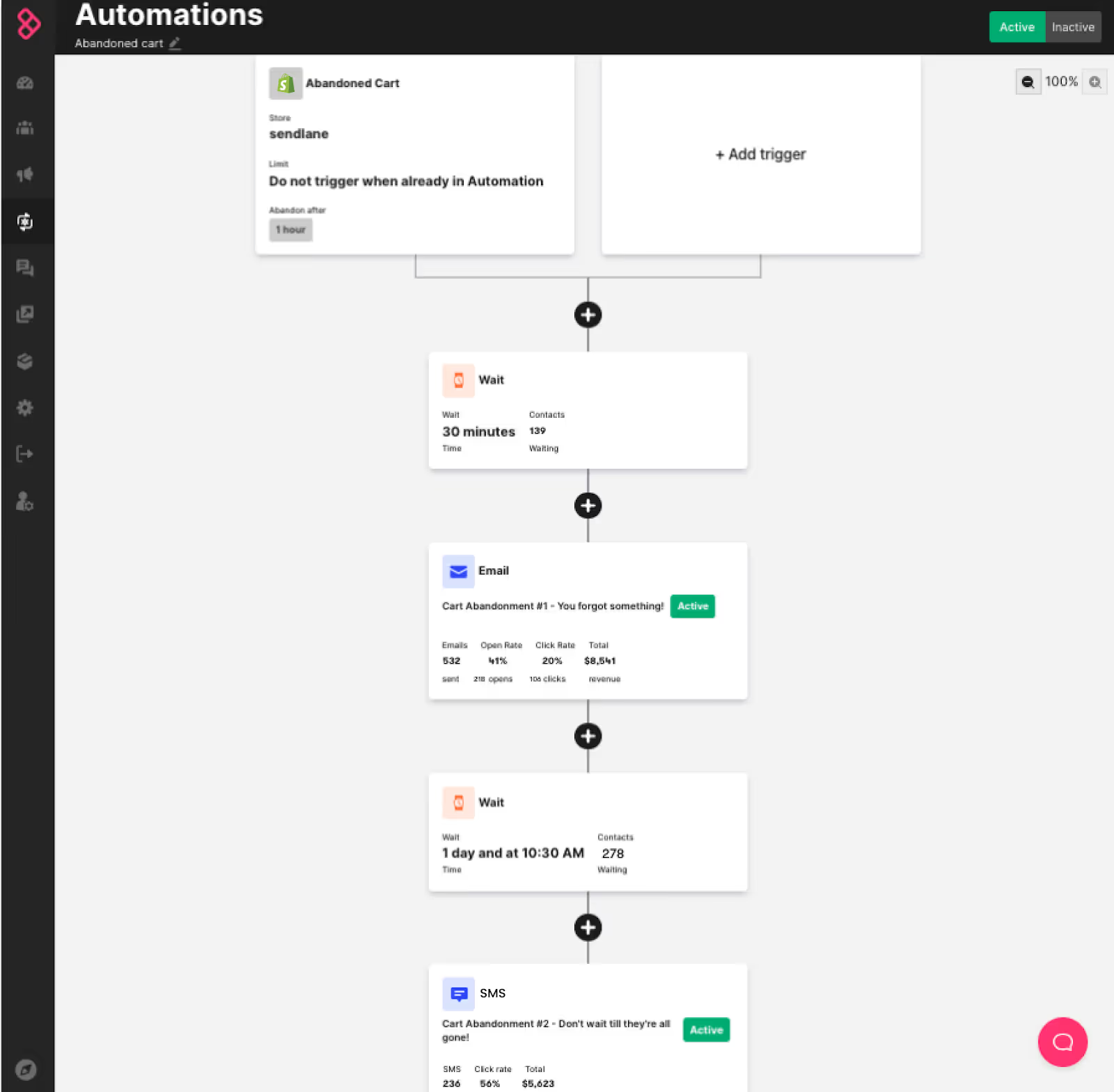
Then, you can customize it by adding timing triggers (like waiting two days to send the second abandoned cart reminder) and even other strategies like SMS. Which brings us to our next step…
6. Invest in SMS marketing
Sending SMS messages to customers is a way to reach them with special offers, promotions, alerts, and product information in a personal way.
Think about it. We all carry our phones around, right? And if a brand sends us a text message, there's a pretty good chance we will read it. In fact, 70% of consumers say a text is a good way for a brand to grab their attention, and messages with images (MMS) are even more effective with a 15% higher click-through rate (CTR).
The great thing about SMS marketing is how versatile it is. You can use it for upsells, abandoned cart recovery, re-engagement and to promote retail sales and discounts.

Just getting started with SMS marketing? Check out our super helpful guide to different strategies and best practices 📖
7. Focus on social commerce
Last year, almost half of US adults bought something on social media platforms.
And it shows no signs of slowing down. By 2030, social commerce is predicted to triple in size and be worth around $3 trillion. Most out-of-the-box eCommerce platforms like Shopify and BigCommerce already integrate with popular social media channels like TikTok, Instagram and Facebook. But to make your social commerce strategy a success, you should:
🎯 Think about your target audience: Do your customers scroll on Facebook or watch shorts on YouTube? The audience demographic and segment you want to target will decide what marketing channels you post to.
👩💻 Use different marketing channels wisely: Instagram? Facebook? TikTok? Only use the channels that make sense for audience engagement and think about what type of content works best. Long posts or discount campaigns might work well on Facebook, but you'll probably get better interactions on TikTok with short videos
French boutique SweetPlaid recently used a mix of Facebook ads and social shopping campaigns to win over customers:
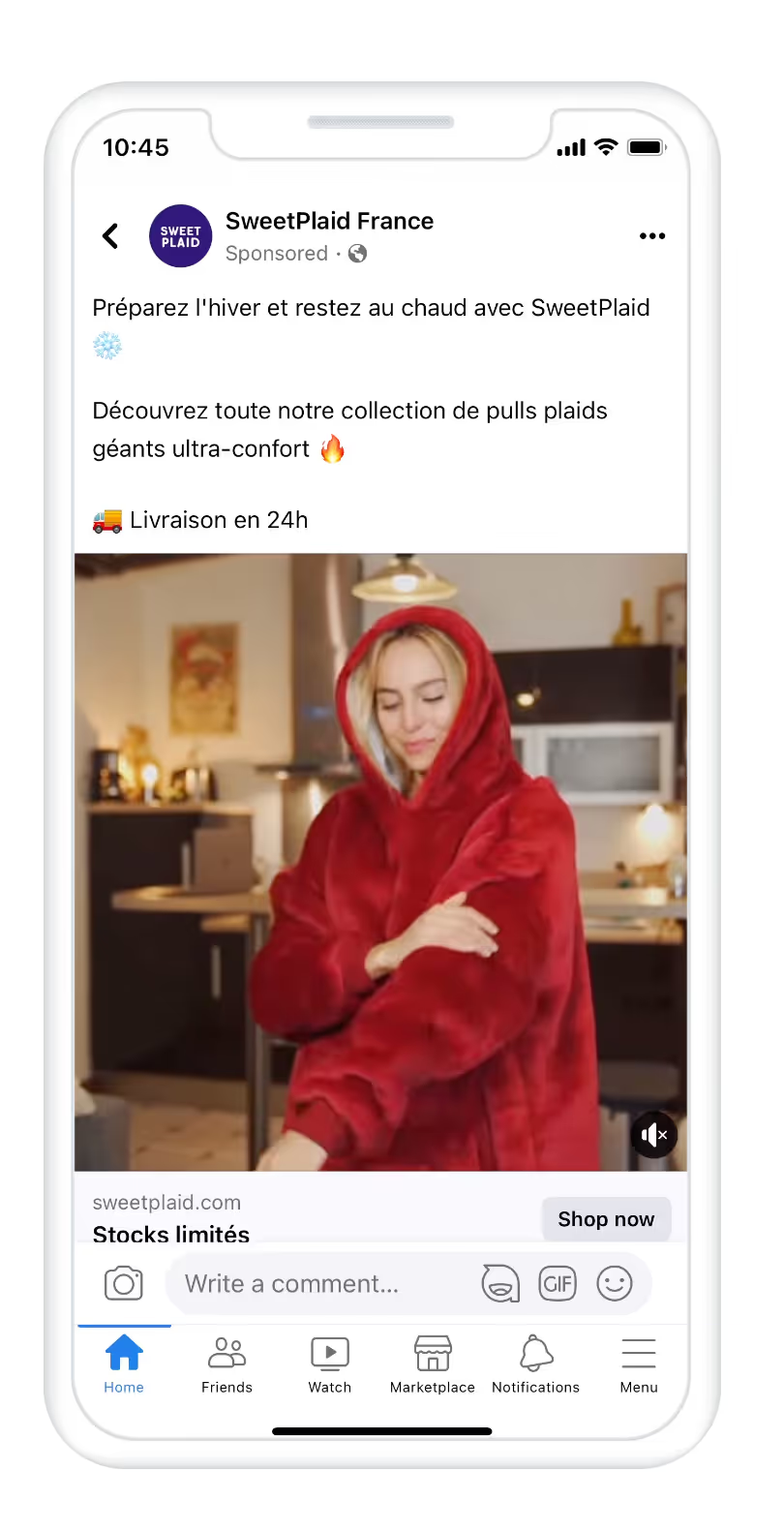
The brand used Facebook's Advantage+ shopping campaign to combine different segmented audiences into a single campaign and ran A/B tests to see what worked best. The results were huge. SweetPlaid increased conversions by 2.8X. And thanks to a combination of video ads, Instagram posts and catalog ads, the brand managed to decrease its cost per sale by 64%.
Pro-tip: Want to start using social commerce in your digital marketing strategy? Our guide will walk you through how to get started and what social media marketing channels you should be using!
8. Reward VIPs and customer loyalty
Loyal customers are the bread and butter of any eCommerce brand.
Repeat customers spend 67% more in their overall lifetime value (LTV.) And to say thanks, your brand should give these loyal customers the VIP treatment. A custom VIP program can drive customers to make more purchases, leave reviews or even refer their friends depending on how you set it up.
One of our favorite VIP programs is by lux fashion brand Farfetch.
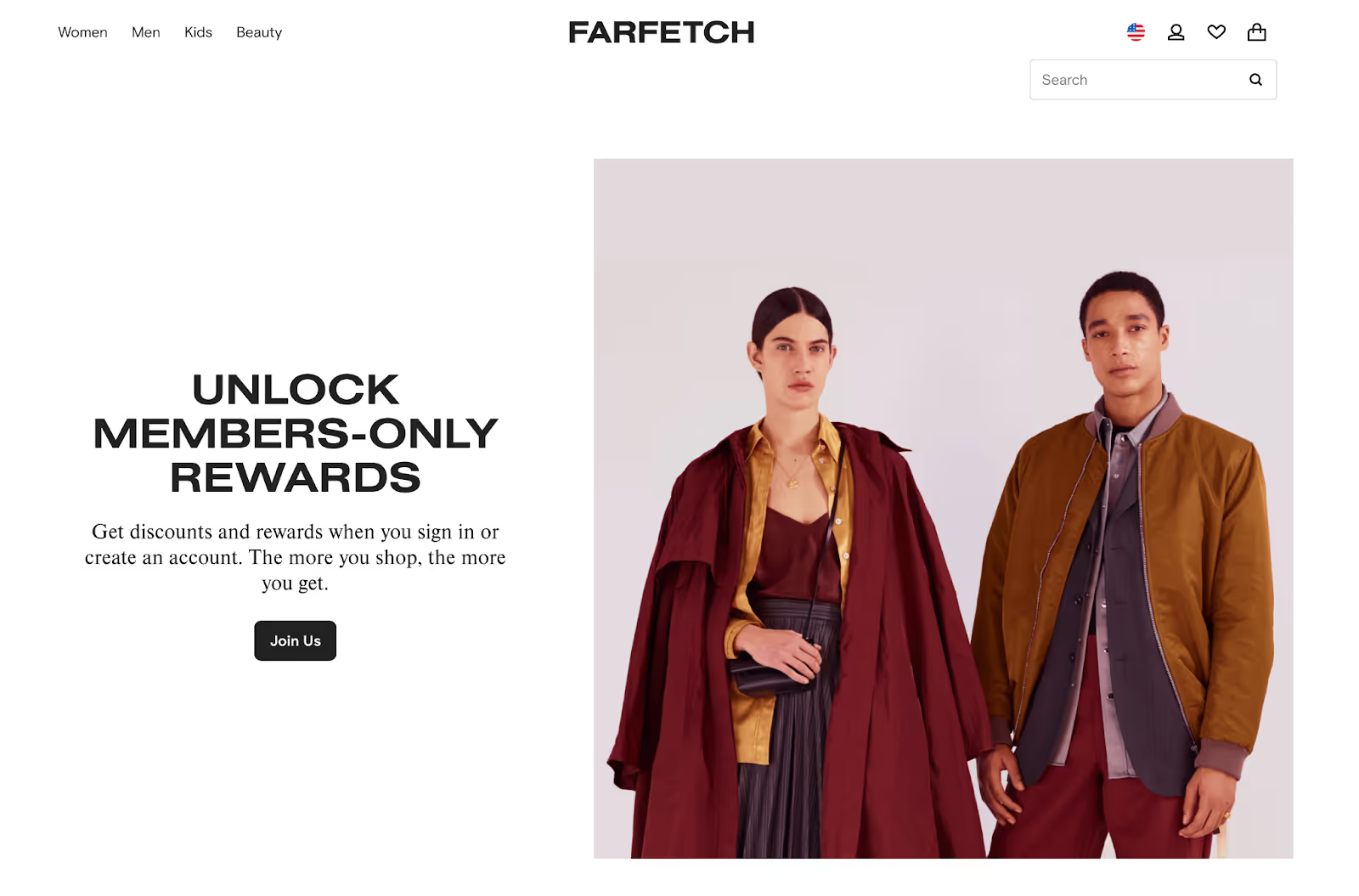
Customers can sign up for the program after their first purchase, and their loyalty rewards restart every 12 months. They will either be upgraded or downgraded to the right tier based on their spending:

For example, customers on the Bronze tier will get a birthday reward and access to early sales. But if a customer spends $6,000, they unlock free shipping, exclusive discounts, priority service and access to exclusive brands, collections, and pieces.
Yes, it's a big price tag. But we love that the rewards are worth it and it's targeted at Farfetch's lux clientele.
Grow your eCommerce with email marketing automation
Building an eCommerce marketing plan from the ground up is no easy feat.
To make it a success, be honest about the flaws in your current digital marketing strategy, sharpen up your SEO and most importantly—engage your target audience. With a tool like Sendlane, you can use marketing automation to grow your eCommerce and nurture customer loyalty. You can create personalized, automated email and SMS messages right out of the box and launch unique journeys to engage customers and win more sales.
Want to try it for yourself? Sign up for our 60-day free trial here—no credit card needed!



%20(1).avif)




%20(1).avif)
%20(1).png)
.avif)


.avif)
.avif)


.avif)





.avif)



.avif)





.avif)


.avif)

.avif)
.avif)

.avif)
.avif)

.avif)

.avif)


.avif)
.avif)
%20(1).avif)
.avif)









.avif)











.avif)
.avif)

%20(1).avif)

%20(1).avif)



.avif)


























.avif)











































.avif)



.avif)




























.avif)



.avif)

.avif)

.avif)
.avif)


.avif)













.avif)

.avif)










.avif)












.avif)






































.avif)



.avif)

.avif)

.avif)
.avif)

.avif)
.avif)

.avif)

.avif)

.avif)

























